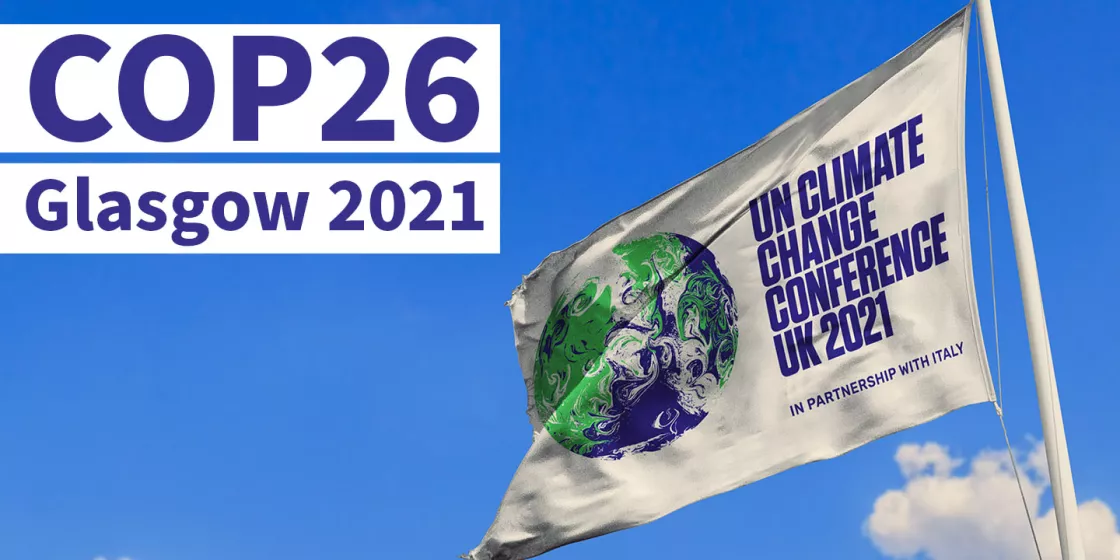The outcome of the UN climate conference is one of ambivalence: while there is strong momentum for phasing out coal and pressure being placed on reluctant climate action, for the 1.5 degree limit to come within reach, China in particular needs to improve its climate target soon and the US needs to implement its very well. In addition, results on the issue of Loss and Damage are insufficient.
- Introduction and Overview
- Negotiation Topics
2.1. Mitigation
2.2. Adaptation
2.3. Climate-induced Loss and Damage
2.4. Climate Finance
2.5. Rule Book (article 6, transparency framework, 5-year timeframe) - Outlook
Expectations for the 26th Climate Summit COP26 in Glasgow, Scotland in November 2021 were enormous. With a summer of extreme weather, the release of the latest report from the Intergovernmental Panel on Climate Change (IPCC) and in Germany, a federal election that was dominated by the issue of climate more than ever before. Culminating in increased political pressure for key outcomes and decisions that address the urgency of action on emission reduction and dealing with climate impacts — adaptation and loss and damage.
The UK COP presidency helped itself to positive press coverage with daily positive announcements from state and non-state actors alike. Theme days addressed energy, financing, adaptation and loss and damage, or transport among others. Key—non-binding—announcements by countries and non-state actors were:
- Under the ‘Global Methane Pledge’ heads of state and governments pledge to reduce methane emissions by 30% by 2030. This is an international initiative by the US and EU to slow warming in the short term, to which more than 100 countries signed up.
- The new ‘Beyond Oil and Gas Alliance’ (BOGA) brings together countries committed to ending oil and gas production within their borders. BOGA's core members are Costa Rica, Denmark, France, Greenland, Ireland, Sweden, Wales and the Canadian province of Quebec.
- Supporters of the ‘Agreement to End International Fossil Fuel Financing’ will end new direct public support for the international ‘unabated’ fossil fuel energy sector by the end of 2022. When Germany joined the initiative State Secretary Jochen Flasbarth pointed to the limited and clearly defined cases in gas financing that are consistent with limiting warming to 1.5°C and thus the goals of the Paris Agreement.
- Following the Scottish government's pledge of £2 million for climate change induced loss and damage, a group of philanthropic organizations have already pledged a further $3 million.
- Germany has also pledged €10 million in funding for dealing with loss and damage—earmarked exclusively to support the Santiago Network for loss and damage.
COP26 kicked off with the ‘World Leaders Summit’. Here, leaders were called upon to communicate their revised 2030 climate targets, long-term strategies toward 2050 as well as national implementation activities and expectations for COP26 – five (six due to the postponement of the summit because of the COVID-19 Pandemic) years after Paris. India stood out, particularly due to Prime Minister Narendra Modi announced five new elements for mitigation. Amongst others, this includes: an increase in non-fossil energy to 500 GW and 50 % of electricity generation from non-fossil energy by 2030 as well as a net-zero target for India in 2070. The latter is calculated more in terms of geopolitics than model-based energy policy. This reworking of the targets is part of the ambition mechanism adopted in Paris to steadily close the massive gap between countries' national climate targets and the adopted global temperature target.
Thereafter, focus of the climate summit was on the actual negotiations and their decisions. On the agenda: concretization of the 1.5°C limit, more and faster mitigation, the phase-out of fossil fuels, protection of those particularly affected by damages and losses, better international climate financing and the conclusion of the so-called ‘Rule-Book’ of the Paris Climate Agreement.
In retrospect, this climate summit could one day be seen as a turning point for phasing out coal worldwide. This is despite China, India, Iran, Venezuela and Cuba all insisting at the last minute, that the coal text be toned down, from 'phase-out' to 'phase-down'. But despite the momentum this climate summit has built for a global coal ‘phase-out’ and more climate action, the 1.5 degree limit is no longer within reach without rapid revisions to the targets of the largest emitters and their implementation. Tightening China's 2030 climate target and credible implementation of the U.S. targets are now critical next steps – India must also submit and then implement the Nationally Determined Contributions (NDCs) revisions announced at COP26.
Globally, we have significantly more momentum for climate action and coal phase-out from countries, companies, the financial sector and civil society than ever before. We must now use this to work internationally, in the EU, in Germany with the new German government and through solidarity-based international cooperation towards societal tipping points that bring the 1.5°C temperature limit back within reach. At the G20 summit in Italy – just before COP26 – all G20 countries had announced greenhouse gas neutrality targets for or around 2050. What is needed is not only to invoke announced climate plans and long-term goals for the middle of the century, but also to implement them. In general, this summit has shown as clearly as ever before that the language accepted at the G20 summit is the basis for important compromises in the UN climate negotiations. On the other hand, the G7 language often paves the way for corresponding G20 language.
The political COP decision was intended to provide a response – in addition to the enhanced NDC targets by states – to the high expectations for the summit ("last chance", etc.). The outcome highlights the state of ´alarm and utmost concern’ of the scientific community. It makes clear that the 1.5°C limit has now become accepted as the necessary interpretation of the ‘well below 2°C’ goal of the Paris Agreement. And this temperature target is operationalized, based on the IPCC: global emissions must fall by 45 % globally between 2010 and 2030. Currently, however – according to the decision – the targets suggest a 13 % increase by 2030. So those who have not yet, or insufficiently enhanced their 2030 climate targets are urged to do so by the end of next year. This call to implement the targets and measures set could have been expressed more strongly, after all, what is at stake here is whether the 1.5°C limit remains within reach. In addition, all countries are urged to improve their respective targets to fit 1.5°C as early as next year, if possible. To close the existing gap (1) a work program was agreed upon, (2) a synthesis report of long-term strategies in 2022, (3) annual updates of the synthesis report of NDCs, (4) ministerial meetings on 2030 targets, and (5) the necessary alignment of the 2030 targets with the long-term goal of greenhouse gas neutrality was also noted.
In retrospect and as mentioned previously, COP26 could one day be seen as a turning point for phasing out coal globally, regardless of the fact that China, India, Iran, Venezuela and Cuba all toned-down the coal text from 'phase out' to 'phase down' at the last minute. But the 1.5°C scenarios, such as those from the International Energy Agency (IEA) clearly show that with this temperature target a coal ‘phase-out’ is needed in developed countries by 2030 and in emerging economies by 2040. This accelerated coal phase-out in industrialized and emerging economies – and even the leapfrogging of the fossil fuel era for countries in the Global South – will require significant efforts and corresponding offers of support for poorer countries that want to advance their social and economic development without coal, oil and gas. The partnership between Germany, the USA, Great Britain and the EU Commission, with South Africa for a ‘socially just’ coal phase-out, which was newly agreed upon on the fringes of COP26 can develop a model character for this. Other countries have already signaled their interest in such a partnerships. The new German government must provide Germany's foreign climate policy with an appropriate mandate and the necessary financial and human resources in the BMU, BMZ and Foreign Ministry. Countries like Indonesia, Pakistan, the Philippines, Rwanda, but also giants like India are possible partners in the next "round". Such an agreement with India could become an international milestone to bring the 1.5°C limit within reach.
Global changes in average temperature – accompanying seasonal shift as well as the increasing frequency and severity of extreme weather events – or even the slow onset processes such as sea level rise, the expansion of deserts to the ever-increasing risk of reaching tipping points all require countries and local decision-makers to implement adaptation measures. They must respond to the impacts of climate change that are already occurring and prepare for unavoidable future impacts. But despite this urgency, adaptation has not yet found the necessary relevance in the UNFCCC process – especially compared to mitigation. It is therefore important that those most highly affected and less adaptive countries of the Global South to obtain greater recognition of adaptation at COP26. This was achieved to some extent in the political decision and a newly established ‘Glasgow-Sharm el-Sheikh Work Programme on the global goal on adaptation’. One of the key demands of the developing countries was that the global goal on adaptation (GGA) agreed in Paris should finally be specified and fleshed out. This two-year work program under the subsidiary bodies, SBSTA and SBI, is an important decision to establish the missing balance between mitigation and adaptation in the UNFCCC process. The Maldives and Egypt have already offered to host the first two of the four annual workshops. In addition, the interim negotiations in June 2022 will take up the work program. Thematically, the upcoming IPCC Working Group II report on adaptation will be included in the discussions. There will be a first report on the GGA work program at COP27 and another at COP28. The Egyptian COP27 presidency has already announced interest in the GGA and will need to explore what specific decisions can be adopted, meeting demands by the most vulnerable countries that industrialized and emerging economies can support.
Substantial progress was also made in the area of adaptation finance (see 2.4.).
2.3 Climate-induced Loss and Damage
Climate change impacts are already a reality for millions of people worldwide, especially the poor – those who have contributed the least to the climate crisis. At COP26 the international community has failed to provide the most vulnerable people with adequate support, matching their needs and recognizing the magnitude of the problems of dealing with loss and damage. It is becoming evident again and again that the UNFCCC process on loss and damage (L&D) – which is bound to consensus, fails to find adequate answers to this challenge due to the vehement veto of countries like the USA, Japan and France. As a minimum solution COP26 has decided to set up the "Glasgow Dialogue" between negotiating parties, relevant organizations and stakeholders to discuss options for financing loss and damage measures by June 2024 (SB60). This must become the starting point for exploring as early as next year how appropriate responses to this equity scandal can be found within and outside of the UNFCCC process. For the Ahr Valley €30 billion was provided, which corresponds to a multiple of public money than what is provided by the entire world community for those in poor countries affected by the climate crisis.
The vulnerable country negotiating groups (G77, LDCs, and AOSIS), representing about ⅔ of the negotiating parties, had introduced a proposal for a “Glasgow Loss and Damage facility” to finance measures to deal with loss and damage into the process. However, its establishment failed due to opposition from developed countries. The Glasgow Dialogue process, set up during COP26, must show at COP27 in Egypt ways to put an end to the cynical procrastination of solutions. In this regard, it is hoped that the G7 and the Petersberg Climate Dialogue will produce groundbreaking proposals. Proposals for solutions and the corresponding financial support must not be allowed to drag on until 2024 – the end point of the dialogue.
References to loss and damage were also missing from the COP political decision on the new collective quantified financing target and were included in the final decision only to a very limited extent.
On the positive side – but far below what was necessary – was the operationalization of the ‘Santiago Network on Loss and Damage’, established in Madrid at COP25, which includes the definition of specific functions. It was also decided to financially support the network with resources for technical assistance to developing countries in implementing relevant approaches to avert, minimize and manage losses. A process will clarify the institutional design of the network by COP27. Germany was one of the first countries to announce €10 million for the Santiago Network.
A primarily symbolically important signal was that the Scottish government (as mentioned in the introduction) announced the very first specific pledge to address loss and damage (£2 million). Private foundations supplemented the sum beyond that ($ 3 Mio.).
Climate finance has generally ranked high as an important implementation and trust element in climate negotiations. COP26 also marked a particular milestone with (1) the first-ever assessment of the pledge by developed countries to provide $100 billion by 2020 to developing countries , and (2) the start of deliberations on the new collective quantified target for climate finance after 2025.
The admission by developed countries – just days before the start of COP26 – that the $100 billion per year target would likely not be reached until 2023 led to a significant loss of confidence on the part of developing countries even before the negotiations began. Developing countries also made it clear that adequate climate finance to meet the 1.5°C temperature target and manage climate impacts would actually need to be many times higher. Developed countries avoided making the obvious link between the 1.5°C target and climate finance – likely out of concern about the magnitude of climate finance requirements that would entail. Despite the fact, that this would reduce the rate at which adaptation and loss and damage (L&D) finance would be required. The European Union, traditionally one of the more progressive voices within the industrialized world acted passively out of concern of a possible gap in the event of non-payment by other donors (especially reliability of the US). The possible impact of the upcoming US midterm elections played a restraining role here. As usual, the US acted as a brake on climate financing. Its blockade resulted in neither a commitment to reach the $100 billion average between 2020 and 2025, nor a binding commitment to provide the sum by 2023 at the latest.
With the impacts of climate change intensifying globally, developing countries prioritized adaptation and L&D financing in their demands at COP26, calling for a significant increase in adaptation finance with the goal of achieving, in part, a balance of finance for adaptation and mitigation set out in the Paris Agreement. The demands for adaptation finance were at least partially accepted. The final decision upgrades adaptation finance with a separate chapter and calls for developed countries to at least double adaptation finance collectively by 2025 compared to 2019. In addition, several developed countries made new pledges totaling $356 million to the Adaptation Fund – the highest amount ever pledged to the fund. At the same time, they failed to provide predictability through multi-year pledges and did not provide assurances that this upward trend would be maintained. While these pledges are an important signal they represent only a drop in the ocean when, according to estimates by the United Nations Environment Organization, some $300 billion in adaptation finance will be required annually in developing countries in 2030. The final decision missed a key reference to the importance of grants and highly concessional funds during the negotiations. Again this was likely due to pressure from the United States, which aims to increase the role of the private sector in the provision of climate finance, despite adaptation finance remaining heavily dependent on grants. Complementary decisions such as those on long-term finance were weaker. The potential contribution to adaptation finance from carbon markets under Article 6 (see 2.5.1.) was diminished by having intergovernmental trade under 6.2 contribute to adaptation finance only on a voluntary basis, despite clear requests. The US resisted, interpreting it as a taxation and requiring congressional approval. At least the Glasgow decision provides that a 5 % fee levied on emission allowances traded under the 6.4 mechanism will go into the Adaptation Fund. This is welcomed.
Another key issue on the finance agenda was the question of access to climate finance. Classically, this issue has been viewed primarily as a capacity problem on side of the developing country. This time too, the lack of strong frameworks in developing countries was discussed as part of the problem. It was at least recognized, on the other hand, that an effective and coherent climate finance landscape is also a prerequisite for better access to finance for developing countries.
Aspects beyond classic climate financing from both developed and developing countries are increasingly gaining importance in the negotiations. This is illustrated by the negotiations on the new climate finance target for the period after 2025. Notably China, to which ever more developing countries are indebted, wanted to exclude references to debt, fiscal policy and fossil fuel subsidies – as well as the debate on the necessary expansion of donors. Yet the high debt levels of many developing countries already play an important role in accessing climate finance. In the final declaration this was mentioned with concern for the first time, but only in connection with the COVID-19 pandemic.
There continues to be little room in the negotiations for discussion of the third long-term-goal of the Paris Agreement: to align financial flows with a pathway to low greenhouse gas emissions and climate-resilient development. Despite a stand-alone chapter in the Standing Committee on Finance's biennial report, it remains unclear where the world stands on this goal. While there is the 1.5°C limit on climate action, with a new global target on adaptation to be discussed in the next two years, such a global target with respect to financial flow shifts is not yet in the pipeline. In view of the first Global Stocktake in 2023, this represents a serious gap. Particularly because on one hand, the final declaration calls for the removal of inefficient fossil fuel subsidies and, on the other – outside the UNFCCC process – far-reaching announcements were made by the financial sector at the beginning of the negotiations, including the Glasgow Financial Alliance for Net Zero (GFANZ) – a global coalition of financial institutions committed to accelerating the decarbonisation of the economy. Without criteria for implementing the goal, however, a lack of a framework to effectively operationalize these announcements remains.
2.5.1 Article 6 (Market Mechanisms)
After a delay of three years, the Parties were able to agree on the regulations for Article 6 of the Paris Agreement. Article 6 allows states to trade quantified emission reductions internationally. However, the additional climate benefits promised in the Paris Agreement have not really been achieved by the regulation, and while many detailed rules do a good job of protecting environmental integrity, a significant loophole has been opened with the transfer of Kyoto allowances.
Immediately after COP26 a coalition of countries around the “San Jose Principles” (published in advance of COP25 in Madrid) released a statement pledging to go beyond the article of the Glasgow outcomes. They identified the Glasgow outcomes as insufficient – compared to the principles they had set themselves. The EU should follow this example. Germany was the first industrialized country to endorse the principles at COP25. The central point is that (1) these targets cannot be counted towards existing targets (55 % of the EU, 65 % in Germany) – but only towards additional targets above this level, and furthermore, b) Kyoto certificates which offer no additional climate benefit, cannot be used.
One positive aspect emerging from the Glasgow decision is that a long demanded loophole (notably by Brazil) – the double counting of emission savings – has been avoided. Counting one and the same climate action toward two country targets would have effectively threatened the environmental integrity of the Paris Agreement. In recent years, allowance of crediting has been a contentious issue, but if countries now want to count emissions savings from other countries’ budgets, toward their own climate targets, there must be a corresponding adjustment in the balances. The fact that the signatory states agreed on the most ambitious solution for the calculation basis for determining emission reductions also had a positive effect. In the meantime, it was feared that certificates from forest projects could also be recognized under project-based trading. The decision now does not contain a corresponding allowance from forest projects. This is important as the corresponding proposal would have undermined the ambition of the Paris Agreement. It is also positive that an independent grievance mechanism will be established to allow local communities to raise awareness of potential negative impacts of projects and programs. Properly set up this grievance mechanism can help prevent human rights abuses related to climate change projects. That said, the text does not yet contain strong enough language regarding safeguards, gender and human rights.
However, the regulation is disappointing with respect to the climate co-benefits of trade. International trade under Article 6 should not be a zero-sum game but foster additional emission reduction. There was a missed opportunity in Glasgow to ensure that market mechanisms achieve significant benefits to the overall balance of emissions. The Glasgow decision operationalized this as follows: Under the 6.4 mechanism, it is mandatory that only a few single-digit percentages of traded allowances be set-aside. This means that neither the buyer, nor the seller may take credit for these reductions and they must additionally benefit the climate. For transactions taking place under 6.2 a corresponding set-aside is only voluntary. These results are very disappointing. There would have been real additional climate benefits if the target had been at least 20 %. All the relatively ambitious targets have been watered down under pressure from, among others, the USA, Australia and Brazil. To ensure the promised additional climate benefits, industrialized countries may now use Article 6 in implementation only for additional targets that go beyond the national targets pledged in their NDC, but not to achieve the previous targets.
In terms of a clear conclusion to the Clean Development Mechanism (CDM) and the Kyoto regime, the decision falls well short of expectations. Until the very end it was highly controversial in Glasgow to what extent certificates from the CDM could be used to achieve targets under the Paris Agreement. Countries such as India, which have an interest in the sale of CDM certificates, argued that a large number of old certificates should be allowed to be used for NDC achievement and thus pretend arithmetically that new mitigation is being implemented. These Kyoto-era allowances do not represent additional emissions reductions under the Paris Agreement. In Glasgow, there was a compromise on this: Certificates from projects registered after January 1, 2013, may be used. The estimates of the quantity of certificates vary considerably. This compromise is a bitter setback for the ambition of the Paris Agreement. The only positive aspect is the expiry date of these old certificates (use only for the first NDC of each state).
There are possibilities, however, to limit the negative effects of taking over certificates from the CDM. All developed countries with integrity should commit not to use these allowances in their jurisdiction. Some donor countries or private foundations could join forces to buy up these certificates at low cost and set them aside without harming the climate: in effect, retroactive climate finance for results already achieved. It will also be important for civil society to closely monitor the private sector to ensure that it does not use cheap, second-rate allowances to meet its self-imposed greenhouse gas neutrality targets without any effort on its part. The Expert Group announced by the UN Secretary-General to monitor the announcement of non-state actors will play a key role here in limiting potential risks from the outset.
The second important decision on the Rulebook is the regulation of the in Paris agreed enhanced transparency framework along with its reporting formats. The transparency rules pertain to reporting detailed information on whether countries are meeting their commitments under the NDCs and implementing their climate targets, and most importantly, whether this information is reliable. They ensure that one tonne of CO2 in Africa or China is equivalent to one tonne of CO2 in the EU or Brazil. Countries must also report on climate finance and adaptation measures every two years. One gain in reporting is the voluntary addition of information on climate-induced loss and damage.
The aim of the transparency framework is consequently to build mutual trust between the Parties with progress reports that must be submitted every two years. The reports not only form the basis for the Global Stocktake (GST), but also provide information on critical market mechanisms.
Since the negotiations earlier this year, there had been efforts by emerging economies to renegotiate flexibility, that is, to discuss the extent, scope and specificity to which emerging economies and developing countries would have to report on the implementation of their NDCs. Emerging economies consistently emphasized the need for flexibility (China, Brazil, and the African Negotiating Group) and capacity-building support (African Negotiating Group and Island States) for their reporting in the transparency framework. China even wanted to eliminate entire reporting tables. The group of least developed countries stressed that flexibility should not be used as an excuse for inaction. Switzerland emphasized for the environmental integrity group that the decisions on the transparency framework must not represent a step backward compared to the decisions of COP24 in Katowice (‘modalities, procedures and guidelines’, MPGs). Finally, flexibility has been built in the decision so that countries that cannot fully report on their progress in reducing emissions must give reasons for doing so. Thus, the degree of flexibility remains somewhat self-determined. Since the emerging economies at least did not manage to remove entire tables due to the strong positions of the US (and the EU), this is an acceptable compromise for the common transparency framework, as far as at least the G20 countries, which are responsible for 75 % of global emissions, report fully their progress (or the lack of the same). Compared to the previous system the main achievement of this common transparency framework under the Paris Agreement is that it actually applies to all countries.
Countries are now required to submit their first biennial transparency report and their first national inventory report by the end of 2024. For quality assurance, all countries' progress reports will be subject to a ‘technical expert review’ and a ‘facilitative multilateral consideration of progress’.
Another negotiating success was the decision to adopt a Common Timeframe (CTF) for the submission and implementation of NDCs from 2031 onwards – in line with the five-year GST cycle established in Paris. Many signs pointed in the right direction. The EU had agreed to five years shortly before COP26, and China and the US also said that both would submit an NDC in 2025 covering the period to 2035. During the negotiations the majority of countries were clearly in favor of a 5-year timeframe, and although a few states wanted to keep open the option of a 10-year timeframe, they too indicated flexibility and negotiation options – presumably for tactical reasons.
It was now agreed in Glasgow that all states would be ‘encouraged to submit new plans every five years – the option to do so every 10 years subsequently fell by the wayside. Sufficient pressure must now be built up to ensure that countries adhere to this encouragement. This would greatly strengthen and underpin the Paris Agreement's goal-setting mechanism of regularly jointly tightening its targets. Moreover, because reporting on countries' respective efforts becomes comparable, which in turn supports the Global Stocktake exercise – which is also taking place every five years – the five-year rhythm fits well. Additionally, a common timeframe allows pressure to build on all countries at the same time, thereby building momentum to improve NDCs and bring them in line with the agreed Paris goals.
With the adoption of the Rulebook, the decade of implementation – delayed by a year due to the COVID-19-pandemic – can now begin. There is massive pressure on countries that have not yet submitted their 2030 NDC, such as China and India, as well as those with far too weak NDCs, such as Australia and Brazil, to do so in 2022. Nevertheless, all countries are expected to submit tighter 2030-targets and/or a strategy in 2022 on how to make their climate policy compatible with the 1.5°C limit. This is also expected from the EU and Germany.
Countries that are weak in the implementation of their NDCs, first and foremost the USA, but also Germany, for example, are expected to make a quick start on closing this gap. In Germany, consequent pressure is growing for an effective ”Sofortprogramm” in the coalition agreement.
Climate partnerships such as those between South Africa on one hand and Germany, the UK, the EU Commission and the USA on the other – to promote the phase-out of coal, the massive expansion of renewable energies and the socio-economic perspective in the sense of a ‘Just-transition’ – is now expected to take shape with a number of other important states. The German coalition treaty currently under negotiation should provide a clear mandate for such a foreign climate policy as well as the necessary money and personnel for it in the BMU, BMZ and Foreign Ministry.
In the area of climate-induced loss and damage, developing countries have set themselves the agenda of adopting the finance facility already envisaged for Glasgow at COP27 in Egypt. If this fails – as is currently foreseeable, due to the veto of several rich countries – a pioneering group must initiate a serious financing option. Germany can pave the way for this within the framework of the G7 presidency and at the Petersberg Climate Dialogue. Germany's financial support for the Santiago Network was a positive signal, but does not yet address the challenges of loss and damage in the countries concerned.
The existing discussions regarding $100 billion per year in climate finance fail to address the real needs of developing countries. With a view to the new post-2025 climate finance target, a paradigm shift is urgently required. The target will need to be aligned with the needs of developing countries and the 1.5°C temperature target – this also means funding to deal with loss and damage. To date, however, any estimates of actual needs are inadequate. This was showcased by the first needs assessment report. Germany should therefore support countries in the next two years to determine their actual needs. This will lead to entirely new dimensions within climate finance. Additionally, this also requires that the rigid division between industrialized and developing countries be overcome and that actors such as China, South Korea and the Gulf states can also formally become donors. New financial instruments such as the use of special drawing rights will also play a role. Barbados has already made a proposal in this regard and France and Italy have also spoken out in favor of their use. To this end, the new German government must amend the Federal Banking Act to allow Germany to pass on its special drawing rights for the benefit of the poorest and most vulnerable.
Beyond climate finance large sums of private finance will be needed for the transformation. With GFANZ and other initiatives the financial sector has positioned itself as the third driving force in the implementation of the Paris Agreement. However, the success of these new initiatives will depend heavily on the seriousness and integrity of their implementation. This depends on the framework conditions that policymakers set for them. At this point, Germany has the opportunity to work together in the G7 and G20 context to further advance the sustainable finance agenda, as well as to take a clear line within the EU, for example, on taxonomy. This must help to close potential loopholes in the widely announced initiatives. Finally, the expert group announced by the UN Secretary General to monitor the announcements of non-state actors plays an important role. Through its recommendations it must set standards that prevent the announcements from ultimately becoming nothing more than useless greenwashing.
In summary, from Germanwatch's point of view, COP26 has brought about some important decisions. The UN climate process will continue next year at the national level – for example on the NDCs – as well as at the G7 and G20 level on, among other things, the most important issues of climate finance. Preparations for COP27 scheduled for November 2022 in Egypt will also be labor-intensive, in order to reach politically difficult decisions on loss and damage finance.













